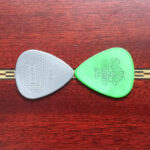The soul becomes dyed with the color of its thoughts, said Marcus Aurelius. If it’s true, then perhaps musical tone can also be changed by the color of an instrument’s strings. Black nylon strings appear radically different than typical clear nylon – but are they?
The reason isn’t explicitly stated by string manufacturers, but black nylon strings are often said to sound brighter than standard strings. Some sets, including red nylon, are sold specifically for flamenco guitar, which is particularly bright and percussive.
In the video below, Grisha Goryachev produces a classic bright flamenco sound playing a guitar strung with black nylon strings. But is it the black dye that is affecting the tone in such a way or a combination of other factors?
Tests find differences, just not in sound
We already know that lower tension nylon strings tend to produce a quieter, but brighter sound than higher tension strings, thanks to a material damping effect related to the strings’ bending stiffness property.
The perception of some guitarists suggests that black nylon strings do sound brighter. However, the science suggests it is unlikely that black coloring has any influence on sound quality because the density and the elasticity of the strings remains the same.
This is exactly what a series of comprehensive tests by Nicolas Lynch-Aird found. He compared clear, black and red nylon harp strings manufactured by DuPont, which were relatively low-cost, and approximately the same diameter (1.13 mm clear, 1.17 mm red, 1.28 mm black).
“For the specific parameter which would relate to the damping, and hence ‘brightness’, of the string – the string bending stiffness – these tests did not show any particular difference between the clear and coloured strings,” Lynch-Aird said.
However, in testing the thermal behaviour of the strings, there did appear to be a difference: the black string was less sensitive to changes in temperature than the clear or red strings, which responded similarly.
“So, while I do not have any evidence to support the contention that dying affects the brightness of nylon strings, I can confirm that dying can affect at least some properties of nylon strings, and furthermore that the effects of dying can depend on the specific dyes used.”
So perhaps there is something to guitarists’ perceptions after all.
Colored nylon may be a different polymer
Colored nylon may also be an indicator that the manufacturer is using a different nylon compound than in its clear nylon sets. Several different kinds of nylon are used commercially such as nylon 6-6, nylon 6-10 or nylon 6-12.
These different polymers can have different acoustic qualities. In fact, the earliest nylon used as guitar strings in the 1940s was said to have a slight “metallic” sound. Another polymer, nylon 6, was popular in the 1980s, but by the early-1990s was replaced by brighter sounding compounds.
Research continues to this day. Unfortunately manufacturers rarely release detailed information about the type of nylon they use or how it is manufactured.
This means guitarists must trial different black nylon strings to find out what works best for them. The table below lists 11 popular string sets with various colored treble strings, including gauge and tension, allowing you to make reasonable comparisons.


















